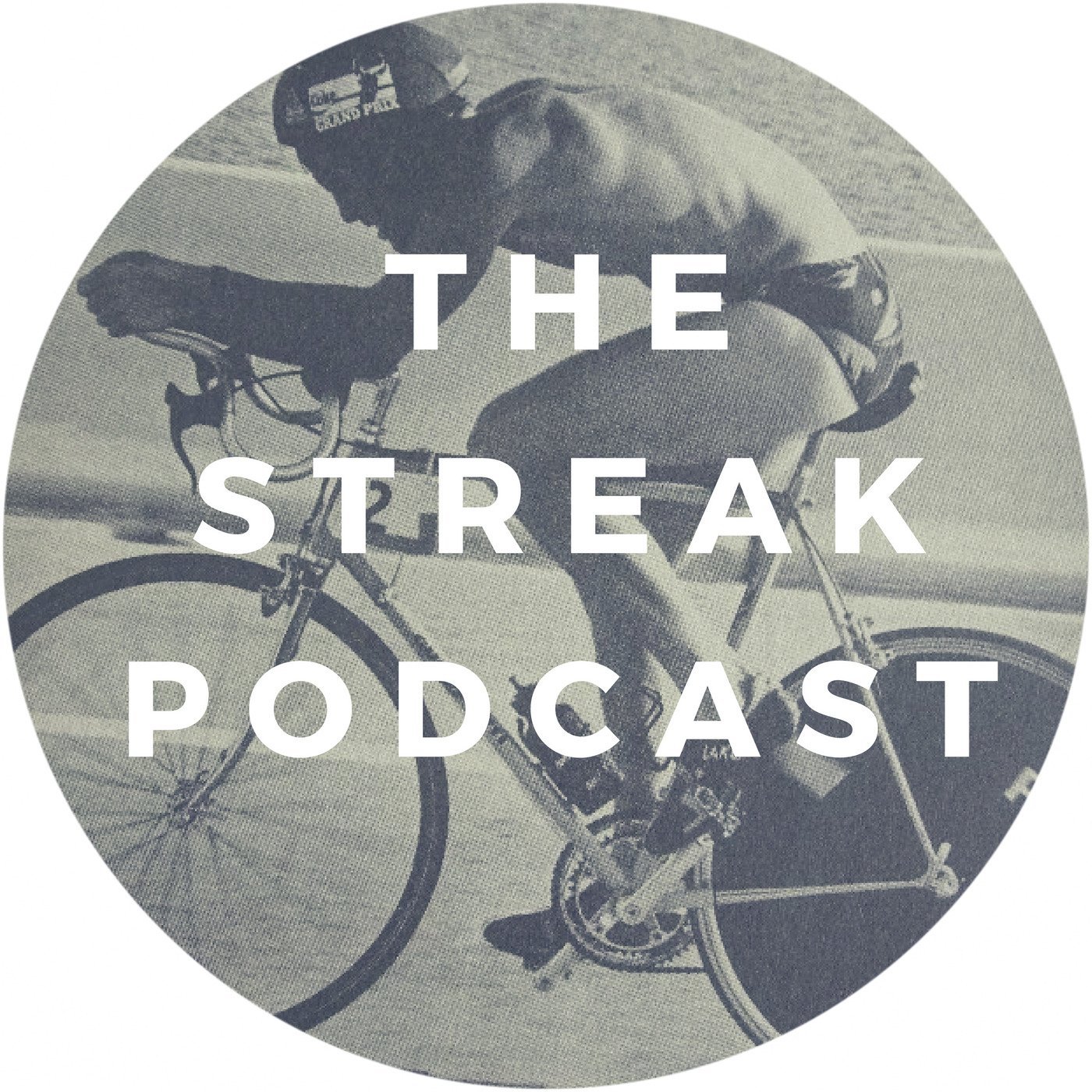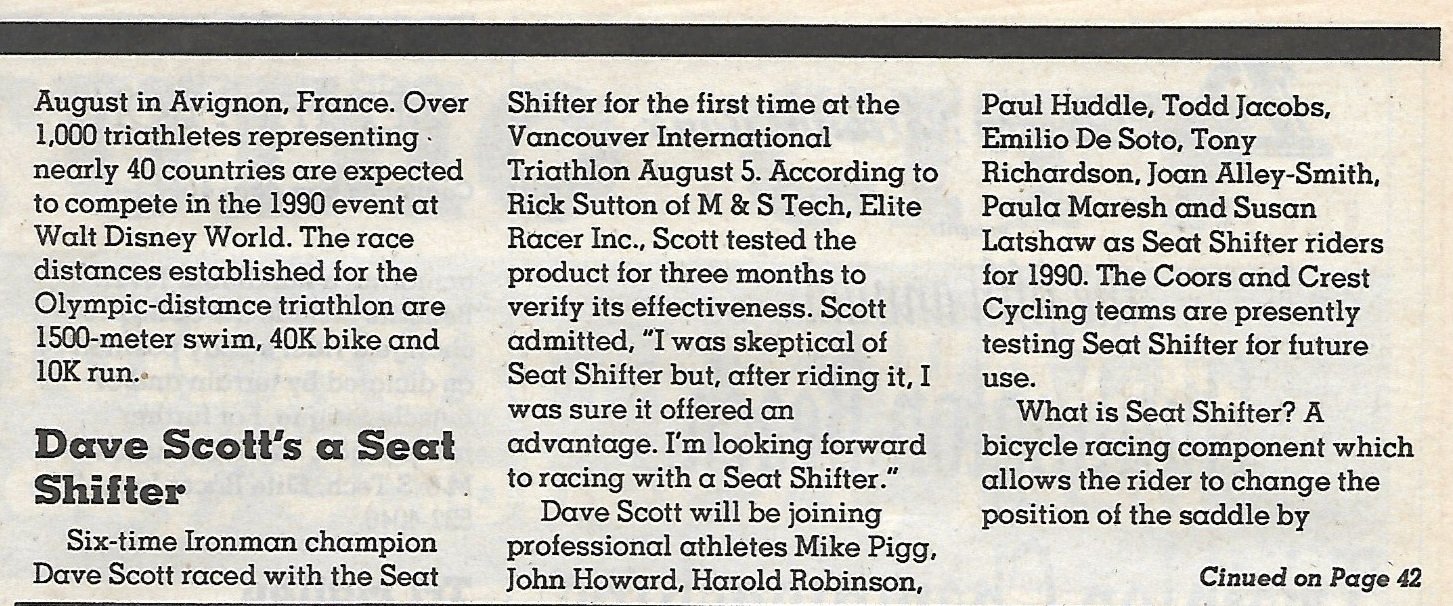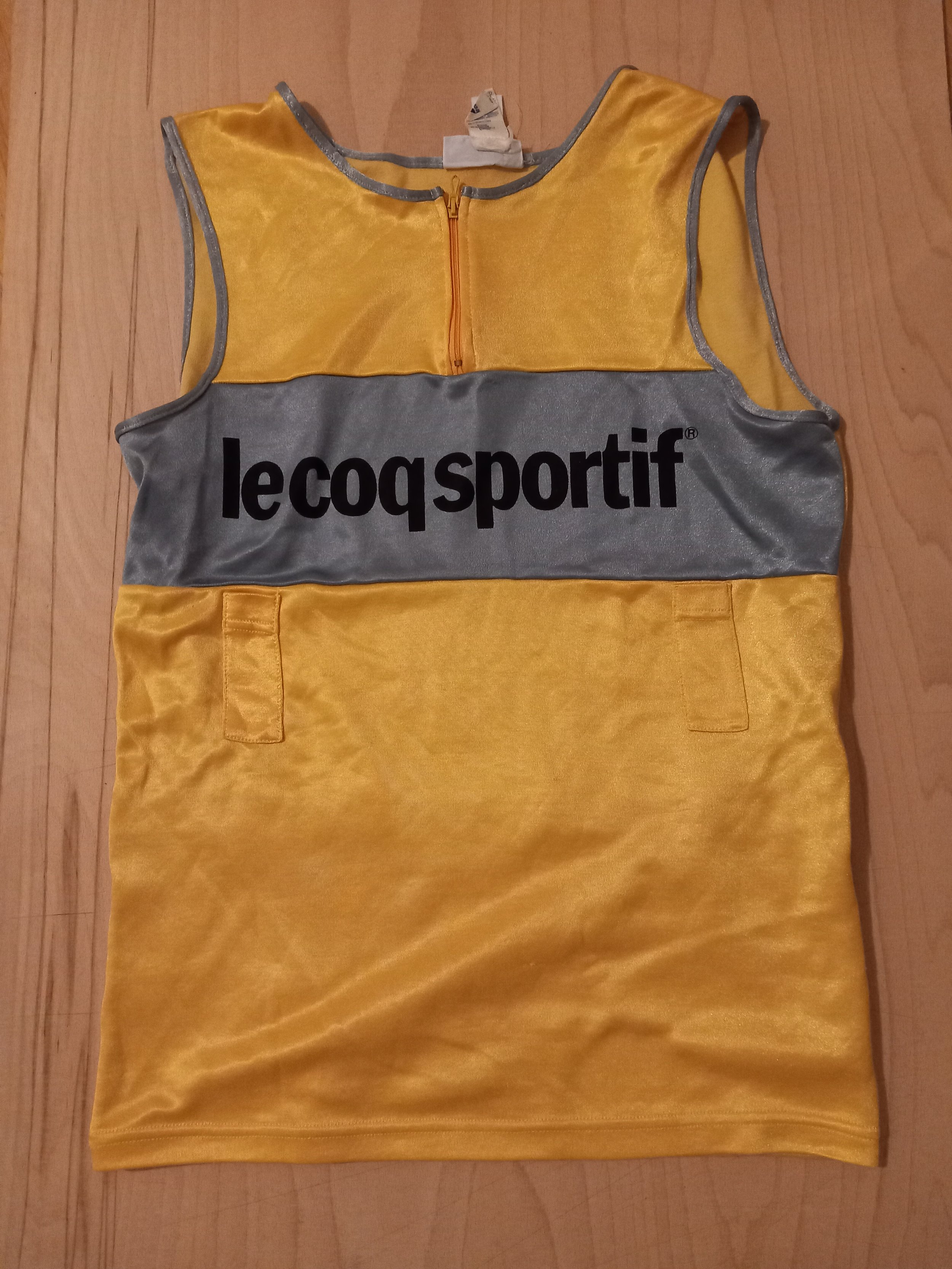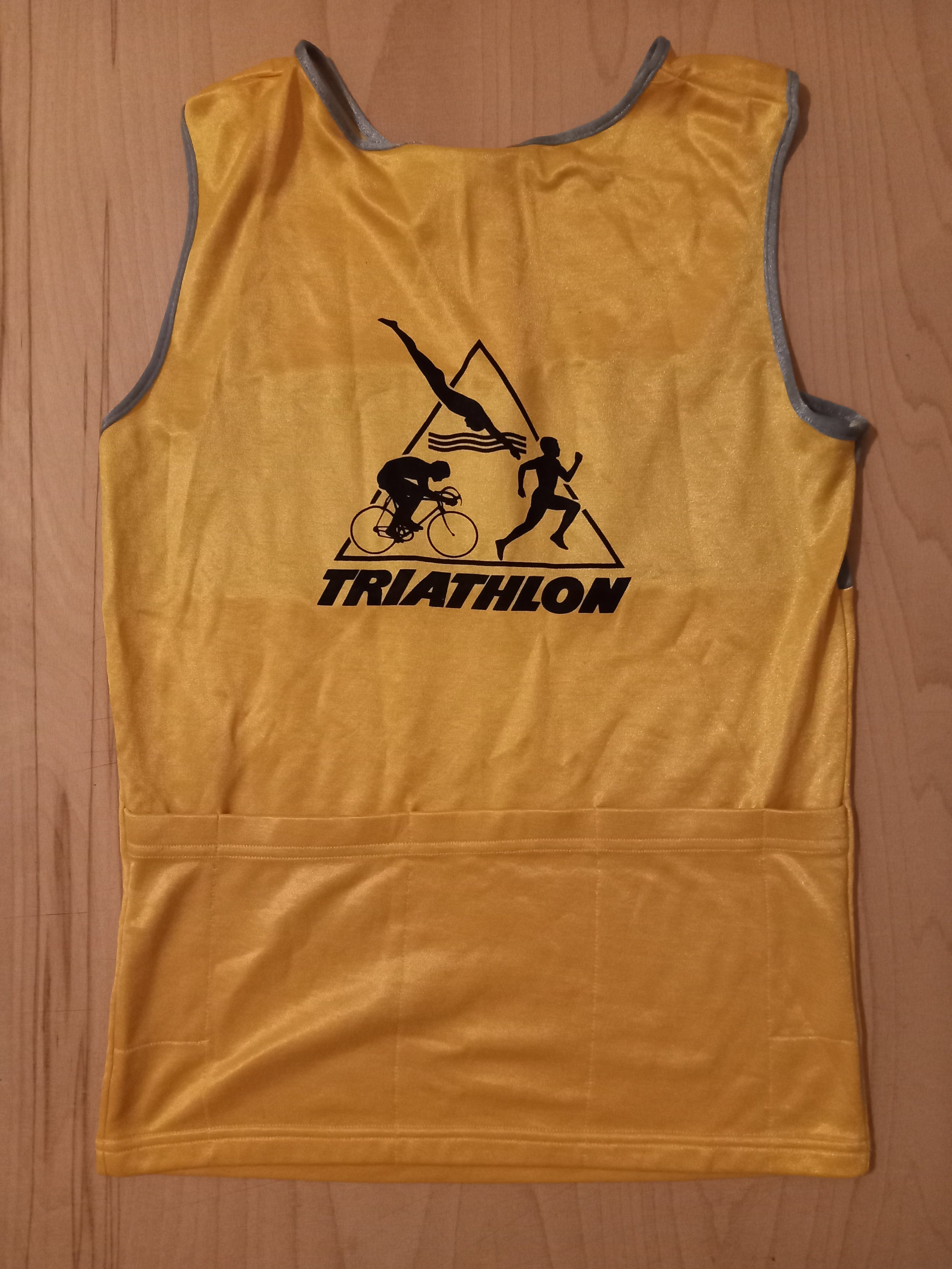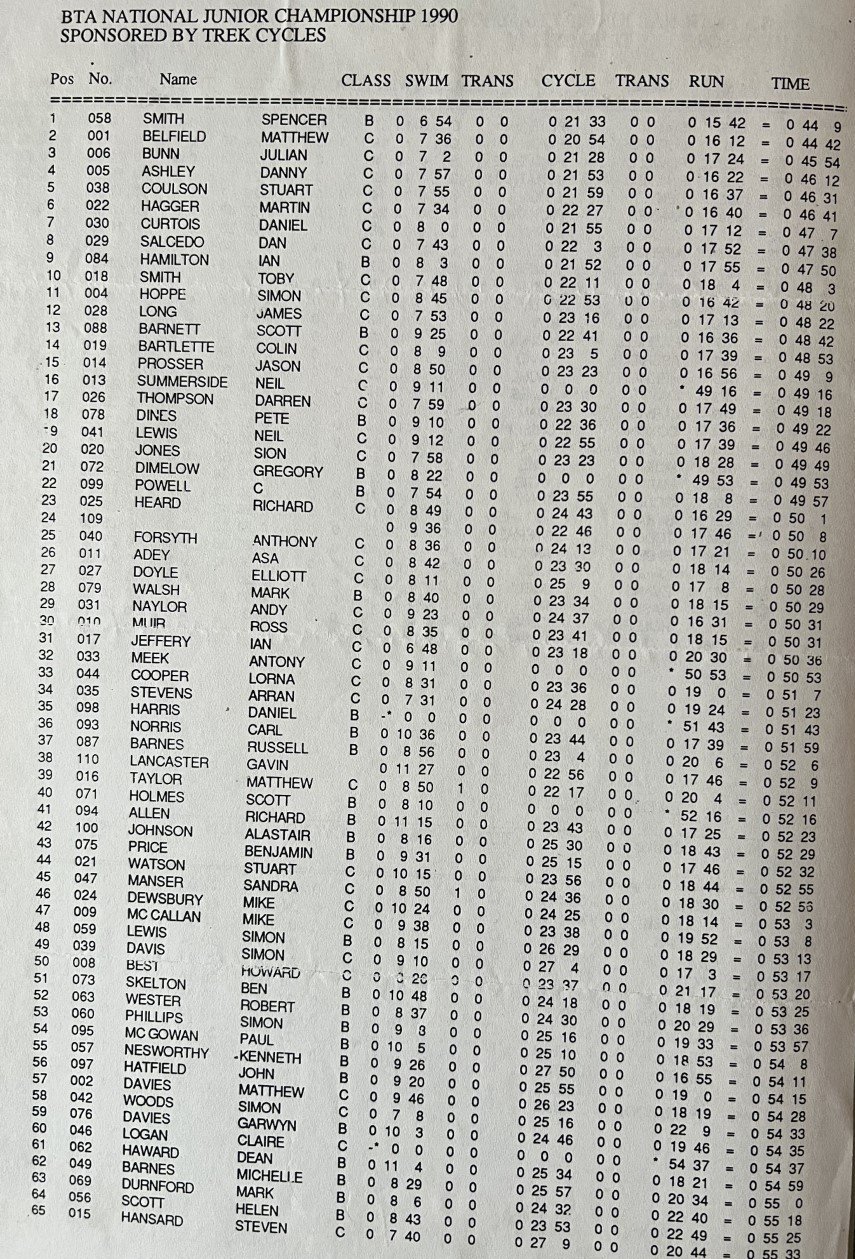The Seat Shifter
Here’s the Seat Shifter. Which really was a 1990 phenomenon. There weren’t many around in 1991. Did the company close? And sponsorships end. Or did athletes not think it gave them a sufficient speed advantage for the time lost due to the weight of the device? More research needed.
I know they used to break though. When I worked at Perfect Performance we had a big box of returned units in the corner of the office.
The Seat Shifter was essentially a spring-loaded sliding system that allowed you to pull a lever on your handlebars and change your saddle’s for-aft position while riding. Further back for climbing. Forward for riding hard on the flat. At least that was the theory. Of course, this would also create small changes in saddle height.
Images: Competitor Magazine (USA) September 1990
The most visible user was Mike Pigg. The video below is the 1990 Nice Triathlon. You get a few glimpses of Pigg and the Shifter.
And although Dave Scott featured in the article and the advertisement above. He didn’t use a Seat Shifter at Nice.
Triathlete (FR) did a product review of the Seat Shifter in July 1990. it’s below. I’ll do a quick translation tomorrow morning.
There were also plenty of non-moving alternatives to get your saddle further forward in 1990. I’ll present some of those soon.
And let’s not forget the Seat Leash! That definitely needs a post.
Images: Triathlete (FR) Juillet 1990
Scott Tinley’s Quiz
Just did it. I got 31.
Answers are here. Write your score in the comments. No cheating.
1989 Triathletes Of The Year
I’ve already looked at the 1986 and 1988 Triathletes Of the Year. So here’s 1989. Mark Allen this time. And Erin Baker again. Both raced 10 times and won 10 times that season. Note that Triathlete Magazine’s most important criteria when making their selections was:
Performance at major international events of all distances.
There’s a bit of a renaissance of this. Knibb, Iden, Charles-Barkley. Blummenfeld. After many years of elite athlete specialisation.
I’m definitely going to have the Best Season Ever debate on here one day. Mark Allen’s and Erin Baker’s seasons below are contenders.
I also rate Simon Lessing’s and Karen Smyers’s 1995 seasons. Lessing won short-course worlds, long-course worlds and the Iron Tour. Smyers did the short-course worlds / Kona double. Like Allen in 1989.
Images: Triathlete (USA) March 1990
The 1984 Coolangatta Gold
The July 1984 issue of Triathlon magazine tells the story of the first year of the Coolangatta Gold Surf Life-Saving event. The race was actually invented to facilitate the making of a film.
Only the trailer and a few clips are on YouTube in English. Oddly, the full-film is available in German!
Images: Triathlon (USA) July 1984
Reading this article motivated me to do some more research. About Guy Leech. Who they call Craig Leech in the article! And the Surf Life-Saving scene in general. It looks great. Especially the Nippers programmes.
I’d like to get involved in the sport. But Munich is somewhat land-locked. I’ll investigate. I was at university with a guy who competed. From Devon. Or Cornwall. He trained with the triathlon club because he also needed to run. But did all sorts of weird underwater stuff during swim sets.
It’s got me thinking about the future of triathlon. And getting events away from roads. Keeping the race self-contained near a beach, in a park or around a swimming pool. Really short distances. Linking swim, bike and run multiple times and in different orders. Heats and finals. Sign me up!
Rick Wells Visits Your School
This is exactly what I wanted to happen after reading this article in Tri-Athlete (UK) in 1988. To replace my piss-poor PE teacher for a day.
I’m not sure if the French version was a direct translation of what I first read. But I’ve got a free period. So here goes. Note. There are few lines in there that are of it’s time. Maybe. Don’t cancel me.
Education and Promotion in New Zealand: Break-Time For Wells!
Making triathlon a sport for all is maybe the near-impossible goal of all the European and american federations. But in New Zealand they’ve done it.
Around Auckland triple-fitness enjoys an unexpected popularity. Nobody is surprised to see a group of cyclists training on Scott DH bars. And even the elite athletes take part in a few low-key local races every year.
The trendy people go to parties in finisher’s t-shirts. And try not to be embarrassed when asked if they wear a wetsuit when the water is below 20°c? Or. Is riding a fixed-gear bike is essential for winter training?
Images: Tri-Athlete (FR) Juin 1988
The secret of this popularity is the tight collaboration between sponsors and the media. Nearly everyday TV shows commercials with Rick Wells promoting cereal bars or a brand of beer. In New Zealand all the breweries get involved in sport sponsorship. Add to that, in the last few years a major international triathlon has been professionally organised. Publicity for the event includes poster campaigns in downtown Auckland and mobile billboards. As well as an hour of prime-time TV coverage.
Triathlon in New Zealand also has two exceptional representatives. Erin Baker and Richard Wells. Who can be thanked in large part for the success of the sport in their country. Wells is a role-model for many young people. Of an unknown athlete. Getting involved late in the sport. But who needs only three years to become world champion. A title he won on enemy territory in Perth in January 1987. This made him a national hero, worthy of extraordinary amounts of publicity. Baker received the same honours after her victory at the Hawaii Ironman in October 1987.
However, the Kiwis are not just relying on their current talent. They’re already preparing the future. With policies based on developing the amateur side of the sport and working juniors triathletes.
Woah! Did you see the world champion?
At 09:25 in the morning in the New Zealand countryside. At an abandoned crossroads a single building is at the centre of a large courtyard. Old pieces of sports equipment lean against the walls. Appearing to hold them up. You need a good imagination to guess that a school is behind the ruins.
At 09:30 about 20 children rush shouting from the classroom and play for a few minutes. Until their teacher brings back some order. She has an old-school teacher look. Hair in a bun. Round glasses. Stern face.
On her signal all the kids sit on a bench in height order. From the oldest. Teenie, age 13. To the youngest. Benjamin, only 2 years old. All the children attend the same school. The youngest are barefoot and the oldest wear gym shoes and t-shirts with the face of Madonna on.
Today is a different type of day. A big day. The man getting his bike out of his car and putting it together expertly is a hero around here.
Richard Wells, triathlon world champion, approaches the group smiling and greats them with a playful “Hi!”.
“Wow! it’s really him. I can’t believe it!” the young girls exclaim together. As one of the younger students asks the teacher if it’s really the guy from the posters. You never know.
Rick’s on a mission. To introduce his sport to schools around the country. Although in villages even more rural than this one there’s a growing enthusiasm for the sport. The absence of initiatives, facilities and equipment make taking part triathlon difficult.
Wells is trying to solve the problem by instilling the basics. In all of the four schools that he visited today, the programme is nearly the same.
He starts by introducing himself. An eternal moment for the young girls who shoot him with loving glances. The boys don’t show much interest in Rick’s career. They’re more into his bike. How do you hold the Scott DH bars? Why is that position so aerodynamic? Rick explains but hardly anybody is listening. Most of the children are picking their nose.
Then. Why do you need so many gears? It appears that the class has preapared for Rick’s visit by working on their questions in advance. And will no doubt form the contents of their next essay.
Over the next 20 minutes the ice is slowly broken until none of them hesitate to try holding the bars, sit on the saddle or squeeze the tyres of Rick’s bike. A big kid even slaps Rick on the back and congratulates him.
A young girl is particularly interested in his cycling shoes and clipless pedals. She clips them in. Unclips them. And then disappears with one of the shoes. Here, like everywhere else such a trophy is priceless.
Rick’s irresistable charm has definitely created a relaxed atmosphere. And the children collapse laughing when he explains how he saves time by urinating in his shorts. Or when he explains the technique of sucking like a baby on a bike bottle while cycling.
These simple school visits establish a contact between the champion and his fans. The children discover the human side of the sport and it’s secrets. With this information, they too could one day become kings of triathlon.
Tinley Take-Aways
Here’s three interviews with Scott Tinley. Tri-Athlete in July 1984, Triathlon in Oct-Nov 1984 and Triathlon in Jan-Feb 1986. The second interview is with Tinley and 1979 Hawaii Ironman winner Tom Warren. Tom was slash still is a huge San Diego triathlon pioneer slash personality.
Warren has a YouTube channel. And Tinley is occasionally on Instagram.
You can learn more about Triathlon and Tri-Athlete in TSP5. I also spoke about Tinley clothing in TSP12. And I urge you to read two of his books. Scott Tinley’s Winning Triathlon. And Triathlon: A Personal History.
Here are my take-aways from the three articles. In list form. Also. How good was triathlon writing back then! The dialogue. The drama.
Tinley was probably the first athlete to build his brand. He had the cool California look. And he did confident yet funny self-promotion. Then came the clothing brand. Merch!
When Scott Tinley and Dave Scott were swapping Ironman titles in the early-80s, Tinley’s wrote “Beat Dave Scott” on his paddles.
Tinley maintained several side-hustles while he was gradually turning triathlon into a full-time job. Fire Fighter. Marina manager. Lifeguard. And marketing trainers at Second Sole.
Like all the athletes back then, Tinley raced a lot. And mixed up short and long. In 1985 he raced 23 times. Probably 6 half-ironman or longer. And the rest around Olympic Distance.
Although Tinley was better at longer distances, he was a big supporter of the USTS races. He was asked to design the distances used in 1982 and 1983. And saw the short course as the best way to get more people into triathlon and promote the sport. High tides float all ships.
Tinley had other hobbies to take his mind away from the mileage. Listening to jazz. Playing his guitar. And making furniture.
Tinley was a member of the controversial J-David triathlon team. Yes. Yes. Will definitely expand on this soon. He had an office in their HQ and organised the racing and travel schedules for the athletes.
Tinley started racing triathlons in 1976 when he moved to San Diego. Back then you needed to know someone, who knew someone, to find out when and where races were taking place. A bit like 1980s Reading.
Tinley trained a lot. As triathlon back then was a physiological experiment and an adventure into the unknown. From this Tinley finished 3rd at his first attempt at the Hawaii Ironman in 1981.
The July 1984 cover of Tri-Athlete is one of the best triathlon magazine covers ever. Currently looking for a yellow base-layer.
1984 Almere Triathon
The first edition of Almere was held in 1983. It was started by Joop Van Zanten. He’d done the Hawaii Ironman in 1981. The race is also still going. And I did it in 2002. Great event. I’d definitely go back.
The first triathlon in The Netherlands was held in September 1981 in Kijkduin. It was pretty much an ironman. As the organisers had either seen the 1981 ABC coverage from Hawaii or read the 1979 Sports Illustrated article. Kijkduin is on the coast. But the swim was held in a 50m pool.
For context, the first triathlon in Europe was probably in Pilsen in August 1980. Pilsen is in the Czech Republic. But was in Czechoslovakia back then. It’s only a 3 hour drive from where I live. I need get over there.
Germany, UK and France didn’t have triathlons until 1982. In April in Essen. September in Reading. As a training race for those going to Nice. And November in Nice. All of these events pre-dated the formation of the country’s national triathlon federation. More info coming!
So here’s 1984 in Almere. The race had 351 starters. Including athletes from Belgium, West Germany, Switzerland, the UK and the USA.
Ardis Bow from USA won the women’s race. And Axel Koenders defended his men’s title. 2nd was Gregor Stam. He won that first event in Kijkduin. 3rd was Rob Barel. Kurt Madden from the USA was 4th.
But I’ve really posted this to highlight Koenders’ outrageous fairings!
Images: Tri-Athlete (FR) Juin 1985
Research And Development Dave
The Dave Scott Signature range of Centurions debuted in 1987. But Dave was hard at work starting in 1984. He had a lab coat, calipers and a security clearance badge. Maybe to get into the top secret Biopace zone.
Image: Tri-Athlete (USA) July 1984
Simon And Brad In Salon
I bought the August and September 1993 issues of Triathlete (FR) when I was over there on a family holiday and racing at Miramont de Guyenne.
The race was a round of the Grand Prix and the French Junior Championships. Not sure how I did. But seeing the speed of the juniors gave me plenty of motivation to train hard through the deep Slough winter.
Although I couldn’t read French at the time, I was intrigued by this article about Simon lessing and Brad Beven sharing a house. Like The Monkees. Or the Beatles in Help! I also thought the photos of Brad stabbing Simon in the back and then pulling his shorts up were pretty funny.
If I have time I’ll do a full translation tomorrow.
Images: Triathlete (FR) Septembre 1993
I’ve always wanted a J-Disc
Last year I picked up a Spengle disc wheel. Made in 1991 or 1992. It’s on the vintage tri-bike that I assembled. Here’s a video.
The first production discs appeared in triathlon in 1984. Mainly the Campagnolo Ghibli and the Mavic Comete. Steve Hed was also down in his basement in St. Paul working on something back then.
Here’s a photo of Mark Allen riding a Comete at the 1985 Avignon Triathlon. Yikes. This link is broken. I’ll try and fix it later. All my vintage next tri-bike build aspirations right there.
And here’s Scott Tinley talking about the Ghiblis. Check out all his kit and equipment photos at the Triathlon History Museum.
“The Campagnolo Ghibli 700c rear disc wheel was perhaps the first highly coveted (and largely unavailable) piece of cycling equipment in triathlon. There were precious few coming out of Campy Europe and the price in 1984 was between $2500--$3000. The wheels were re-cycled from European pro teams that used them in time trials. To show up on race day with one of these was a badge of accomplishment, skill, money, or connections. They were noisy and heavy but on a mostly flat course, much faster than a spoked-wheel. One of the many nuanced challenges was inflating them. This required a specially-fabricated L-shaped device to be fit onto the pump hose. It looked like a 70s hash pipe and there were times when customs agents had some hard questions for those of us who traveled with the adapter.”
But when I started pimping my Dave Russell in the early-1990s I wanted a colourful J-Disc. Like Mike Pigg. They weren’t carbon. Like the Campags, Mavics and HEDs. Instead a taught mylar film was bonded to a spoked wheel. So it was super-light and you could true it.
I even had a friend who made one in his dining room. Using a hair dryer and Super-Glue.
I Bought A 1986 Le Coq Sportif Vest
I got this on eBay. I wrote about Le Coq Sportif shoes and tri-suits here. It fits perfectly! So I’ll do a few races in it next year.
The quality is superb. There’s three large and two small pockets in the rear. And reinforced parts for pinning numbers on the front.
Images: Tri-Athlete (FR) Septembre 1986
Dirk Aschmoneit is wearing one at Embrun in 1986 above. And Glenn Cook at St. Croix in 1988. Below. Is he walking up The Beast?
Images: Tri-Athlete (FR) Juin 1988
1986 Triathletes Of The Year
I’ve already looked at the 1988 Triathletes Of The Year. Here’s 1986. Beautiful shell-suits. Both Linda Buchanan and Mark Allen were sponsored by Nike. I love the polo shirt Mark is wearing.
Linda Buchanan had a pretty short career. 1983-1988. But she won Nice twice (1983 and 1986) and a Hilton Head (1985) in that time. See Triathlon’s Triple Crown 1985. She lists injuries and the loss of the Nike sponsorship as her reason to retire. Buchanana also dated Dave Scott.
Mark Allen’s 1986 season included a win at Nice. His 5th. And 2nd in Hawaii. His best result there so far. After 3rd in 1983. Allen also won in Avignon. Which was growing towards being a significant international rendezvous. I’ve already blogged about the 1985 and 1986 editions.
Images: Triathlete (USA) March 1987
1988 Triathletes Of The Year
I love these Triathletes Of The Year articles. I’ve got a few.
Winners were decided on a full season’s body of work. Performances at the 11 biggest races. Short and long. There was also a Readers’ Poll. And then the editors of Triathlete magazine had their say.
Both Erin Baker and Mike Pigg finished 2nd in Hawaii in 1988. And both won Kelowna. Another Unofficial World Short Course Championships. After Perth the year before. I spoke about that race in TSP11. Baker also won Nice and Pigg won Hilton Head. These races were a big deal back then.
If there had been an Olympic triathlon in Seoul in 1988. I think we can assume Baker and Pigg would have won the gold medals.
Images: Triathlete (USA) February 1989
Freestyle and Molina: Cross Training Specialists
I’m fully back to using just a Timex Triathlon now. No more GPS.
But I’d totally be into getting a Freestyle Shark or Competitor. Sharks are still available here. And I wrote some Molina stuff yesterday.
1987 Triple Crown Preview
Here’s the preview to the 1987 Triple Crown that appeared in the October 1987 issue of Triathlete. I like the We Pick The Winners! Triathlete Magazine’s Triple Crown Predictions article.
Their picks were pretty much spot on for Hilton Head and Kona. Season trends pointed to those. But neither Terry Mulgannon nor C.J. Olivares Jr. even mentioned Rick Wells and Kirsten Hanssen as Nice contenders.
The rest of the preview is also pretty comprehensive. There’s course maps, prize money breakdowns, spectator tips, past winners, how to qualify, travel advice, accommodation options and ideas of other things to do.
The 1987 season really was a cool one. The first with aerobars. And I’ve got plenty of resources to regale you with more tales later.
Images: Triathlete (USA) October 1987
Triple Crown Report 1987
Here’s the 1987 Triple Crown. USTS Nationals in Hilton Head, Hawaii and Nice. Over a four week period. I’ve already looked at 1985 and 1986.
In 1986 monetary incentives payed by Ironman encouraged the pro-athletes to miss Nice and focus on Hawaii. But in 1987 Nice and Hawaii swapped race dates. 1987 was also the first season with aerobars.
Images: Triathlete (USA) January 1988
Hilton Head was won by Kirsten Hanssen and Mike Pigg. They were also the first winners of the Coke Red Jersey as overall USTS winners.
Note that British triathlete, and one of the San Diego training pioneers, Rick Kiddle finished second in the 20-24 age-group.
In Hawaii, Dave Scott won his 6th and final Ironman title. Erin Baker won her first of two. She would go on to win again in 1990.
Note that Britain’s Sarah Springman finished 5th. In 1991 Sarah Coope became the first British athlete to finish on the podium in Hawaii.
1987 was the first year that Mark Allen decided to focus purely on Hawaii and not go to Nice. He was helped in that decision by the date switch. The whole 1987 season is documented in his book, Total Triathlete.
Kirsten Hanssen and Rick Wells won the races in Nice. Video below. Note that Herve Nicquet got France’s first podium at the event.
So. Who had the most sucessful Triple Crown campaigns? Here are my picks:
Kirsten Hanssen (1st in Hilton Head, 1st in Nice)
Greg Stewart (3rd in Hawaii, 5th in Nice)
Paula Newby-Fraser (3rd in Hawaii, 3rd in Nice)
Scott Tinley (5th in Hilton Head, 6th in Hawaii, 2nd in Nice)
Mike Pigg (1st in Hilton Head, 5th in Hawaii)
Ken Glah (3rd in Hilton Head, 5th in Hawaii, 10th in Nice)
The Terminator
By the late 1980s Mark Allen had become my favourite US triathlete. I’d read his book and been regaled with tales from Avignon. I was also already working on my own Grip Of Death on my Peugeot Elan.
I admired Mike Pigg but knew I’d never be as brave as him on the bike. I also liked to think that I ran like Steve Jones. Smooth, light, low to the ground. Pigg was a fast runner. But not textbook.
But the triathlon career I wanted to eventually have was Scott Molina’s. The 1984 Triathlete of the Year. Like me, he came from a running background but he was also super-strong in all three sports.
Molina was also famous for huge mileage. I was sixteen when I started triathlon, but whenever the school holidays rolled around I was out in Slough creating my own Molina-style training programme.
He raced often, 23 times in 1984, everywhere, and across all distances. He travelled to the races with the best prize purses because he wanted to win races and earn money. He was The Terminator!
Scott is also a super-nice guy and took the time recently to help me with TSP3 about Scott DHs. And TSP8 about the France Irontour.
The article above, Terminator 2, is from the November 1994 issue of Triathlete (USA). The piece was written just before the Irontour. Scott explained that he was having a great season even though he’d taken the whole of 1993 off to deal with some back issues.
He’d finished well up in some competitive races. 4th in Cleveland. 2nd at Boulder Peak. And was pretty much back in full training. With a new focus on quality, especially on the bike, over quantity. Below.
Images: Triathlete (USA) November 1994
Also. In the late William R. Katovsky’s editorial piece we get the story of how Scott got his famous nickname.
I have a confession to make. Almost a decade ago, when I wrote a magazine profile on this month’s cover subject, Scott Molina, I had just seen the film The Terminator. The similarities between the futuristic indestructible cyborg killing machine and the indestructible pro triathlete were hard to ignore. Hence I came up with the name Terminator as the title of my article. Funny isn’t it, how some nicknames stick.
Such is my legacy to triathlon.
Pleasingly. Scott Molina is still truckin’ into his sixties. Training and racing near his home in Christchurch, New Zealand.
I also love this story he told on Babbitville about explaining to his first father-in-law that he was going to quit his job and move to San Diego to be a professional triathlete. A job that didn’t exist in 1982.
The Rest Of 1990
My plan for the 1990 triathlon season was to take my Skoda Estelle on tour and do the Carlsberg Grand Prix. The BTA released plans to restructure the series. But unfortunately it never went ahead.
However, I still did my first Olympic Distance race in Swindon and focused the rest of the season on local events such as the BTS Gravel Pit races and the monthly Harry Kitchener Series in Biggleswade.
Preparation for the season started in November 1989 by attending a training camp in Reading (below). I met other people hooked on the sport and rode the velodrome at Palmer Park. This would become a regular training venue until I left the country forever in 1996.
To further prove my growing tri-nerd creditials I also got a letter published in the February issue of 220 magazine.
At Christmas I got my first turbo trainer from Geoffrey Butler cycles in Croydon. It was a Tacx, front wheel off, fan-flywheel model.
On cold nights I’d crank the Genesis in my parents’ garage and follow sessions from Advanced Turbo Training by Peter Read. I destroyed the fan piece numerous times before retiring the trainer in the late 90s.
As I was planning to study Sports Science at university I wrote to Robin Brew to see if I could help out at one of his training camps. He said yes. Top bloke. And I attended the May novice course below.
Image: 220 (UK) January 1990
Ever since I got a road bike, maybe in 1987, and started doing longer rides out of Slough, I had been doing my own wrenching. Learning by trial and error and getting the occasional tip from Dave Russell.
So it’s surprising to me that it took until the middle of 1990 to have a self-inflicted, race-ending mechanical. It happened at the Farmer Giles Super Sprint Triathlon in Aylesbury. Race report below.
Images: 220 (UK) August 1990
In the week before the race I carried out my first cassette removal and clean. But I clearly didn’t re-tighten the lock-nut enough. So mid-race all the sprockets moved right, off the free-hub. Lesson learnt.
As a fan I was psyched to follow the 220 Marathon Triathlon. This was the ironman distance event organised out of Cotswold Water Park by the 220 Magazine crew. Entry fee was only £2:20 for subscribers.
Images: 220 (UK) May 1990. 220 (UK) July 1990.
A race report is below. I’d actually considered entering. But I found out that I was too young. It would have been a complete disaster. In 1991 they moved the event to Ironbridge and even had Kona slots.
Images: 220 (UK) August 1990. Triathlete (UK) August 1990.
I was hoping to end my season at the Portsmouth International Triathlon. It was the race organised by Tri-Athlete Magazine. In 1988 and 1989 the event was held in Southport. And in 1989 it was covered by the BBC.
But my entry was returned because I wasn’t 18. I remember writing back to say that Spencer Smith also wasn’t 18 yet but they’d accepted his entry anyway. I guess they thought he was going to be a big deal.
Again. Full blog post on that event coming soon.
Image: 220 (UK) August 1990
I ended my junior career by gettting a drafting penalty at the national championships at Holme Pierrepont. My brother, pictured in the race report below, got the crowd pumped by ripping a 10m skid into T2.
The next day I took part in the national relay championships with Berkshire Tri Squad for the second time. The event is still truckin’ with essentially the same format. I’d love to go back one day.
Images: 220 (UK) September 1990
1987 L. Ron Hubbard Triathlon
Image: Tri-Athlete (UK) May 1987
I’m not a member of any religion. But this race intrigues me. Maybe the sponsorship was a recruitment or PR move. I could have done it. As it took place only 10 miles from my home. Two days? Yikes. And I’m assuming the three sports would be done in the fitness centre. The hotel is now the Holiday Inn. And the 1970s-era foyer gets some attention online.
The UK Scientology Headquarters are in East Grinstead. And L.Ron actually lived there from 1959 until 1967. He should have sponsored the local East Grinstead pool triathlon. It was a cult race on the calendar in the late-80s and early-90s. It’s where you went to get schooled by Jessica Harrison or the Herbert Brothers. And was my second ever triathlon in 1989.

